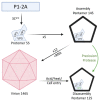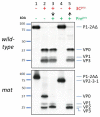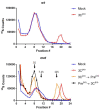An Engineered Maturation Cleavage Provides a Recombinant Mimic of Foot-and-Mouth Disease Virus Capsid Assembly-Disassembly
- PMID: 34072387
- PMCID: PMC8228156
- DOI: 10.3390/life11060500
An Engineered Maturation Cleavage Provides a Recombinant Mimic of Foot-and-Mouth Disease Virus Capsid Assembly-Disassembly
Abstract
Picornavirus capsids are assembled from 60 copies of a capsid precursor via a pentameric assembly intermediate or 'pentamer'. Upon completion of virion assembly, a maturation event induces a final cleavage of the capsid precursor to create the capsid protein VP4, which is essential for capsid stability and entry into new cells. For the picornavirus foot-and-mouth disease virus (FMDV), intact capsids are temperature and acid-labile and can disassemble into pentamers. During disassembly, capsid protein VP4 is lost, presumably altering the structure and properties of the resulting pentamers. The purpose of this study was to compare the characteristics of recombinant "assembly" and "disassembly" pentamers. We generated recombinant versions of these different pentamers containing an engineered cleavage site to mimic the maturation cleavage. We compared the sedimentation and antigenic characteristics of these pentamers using sucrose density gradients and reactivity with an antibody panel. Pentamers mimicking the assembly pathway sedimented faster than those on the disassembly pathway suggesting that for FMDV, in common with other picornaviruses, assembly pentamers sediment at 14S whereas only pentamers on the disassembly pathway sediment at 12S. The reactivity with anti-VP4 antibodies was reduced for the 12S pentamers, consistent with the predicted loss of VP4. Reactivity with other antibodies was similar for both pentamers suggesting that major antigenic features may be preserved between the VP4 containing assembly pentamers and the disassembly pentamers lacking VP4.
Keywords: antigenicity; capsid assembly; foot-and-mouth disease virus; picornavirus.
Conflict of interest statement
The authors declare no conflict of interest.
Figures




Similar articles
-
Foot-and-mouth disease virus assembly: processing of recombinant capsid precursor by exogenous protease induces self-assembly of pentamers in vitro in a myristoylation-dependent manner.J Virol. 2009 Nov;83(21):11275-82. doi: 10.1128/JVI.01263-09. Epub 2009 Aug 26. J Virol. 2009. PMID: 19710148 Free PMC article.
-
The Cellular Chaperone Heat Shock Protein 90 Is Required for Foot-and-Mouth Disease Virus Capsid Precursor Processing and Assembly of Capsid Pentamers.J Virol. 2018 Feb 12;92(5):e01415-17. doi: 10.1128/JVI.01415-17. Print 2018 Mar 1. J Virol. 2018. PMID: 29212943 Free PMC article.
-
Dissecting the roles of VP0 cleavage and RNA packaging in picornavirus capsid stabilization: the structure of empty capsids of foot-and-mouth disease virus.J Virol. 1997 Dec;71(12):9743-52. doi: 10.1128/JVI.71.12.9743-9752.1997. J Virol. 1997. PMID: 9371640 Free PMC article.
-
Viral RNA modulates the acid sensitivity of foot-and-mouth disease virus capsids.J Virol. 1995 Jan;69(1):430-8. doi: 10.1128/JVI.69.1.430-438.1995. J Virol. 1995. PMID: 7983739 Free PMC article.
-
The pH stability of foot-and-mouth disease virus.Virol J. 2017 Nov 28;14(1):233. doi: 10.1186/s12985-017-0897-z. Virol J. 2017. PMID: 29183342 Free PMC article. Review.
Cited by
-
Virulence and Immune Evasion Strategies of FMDV: Implications for Vaccine Design.Vaccines (Basel). 2024 Sep 19;12(9):1071. doi: 10.3390/vaccines12091071. Vaccines (Basel). 2024. PMID: 39340101 Free PMC article. Review.
-
Development of Monoclonal Antibody to Specifically Recognize VP0 but Not VP4 and VP2 of Foot-and-Mouth Disease Virus.Pathogens. 2022 Dec 8;11(12):1493. doi: 10.3390/pathogens11121493. Pathogens. 2022. PMID: 36558827 Free PMC article.
-
mRNA Vaccine Development for Emerging Animal and Zoonotic Diseases.Viruses. 2022 Feb 15;14(2):401. doi: 10.3390/v14020401. Viruses. 2022. PMID: 35215994 Free PMC article. Review.
-
Recent Development of Ruminant Vaccine Against Viral Diseases.Front Vet Sci. 2021 Nov 3;8:697194. doi: 10.3389/fvets.2021.697194. eCollection 2021. Front Vet Sci. 2021. PMID: 34805327 Free PMC article. Review.
-
Foot-and-mouth disease: genomic and proteomic structure, antigenic sites, serotype relationships, immune evasion, recent vaccine development strategies, and future perspectives.Vet Res. 2025 Apr 7;56(1):78. doi: 10.1186/s13567-025-01485-0. Vet Res. 2025. PMID: 40197411 Free PMC article. Review.
References
-
- Donnelly M.L., Luke G., Mehrotra A., Li X., Hughes L.E., Gani D., Ryan M.D. Analysis of the aphthovirus 2A/2B polyprotein ‘cleavage’ mechanism indicates not a proteolytic reaction, but a novel translational effect: A putative ribosomal ‘skip’. J. Gen. Virol. 2001;82:1013–1025. doi: 10.1099/0022-1317-82-5-1013. - DOI - PubMed
Grants and funding
LinkOut - more resources
Full Text Sources

